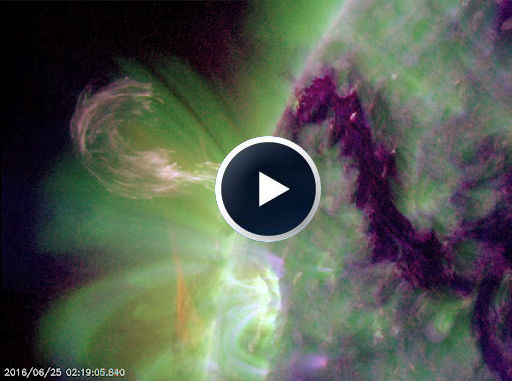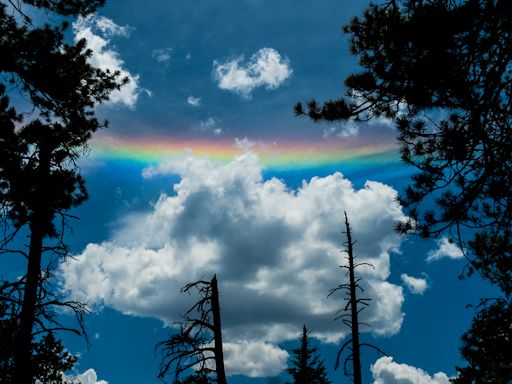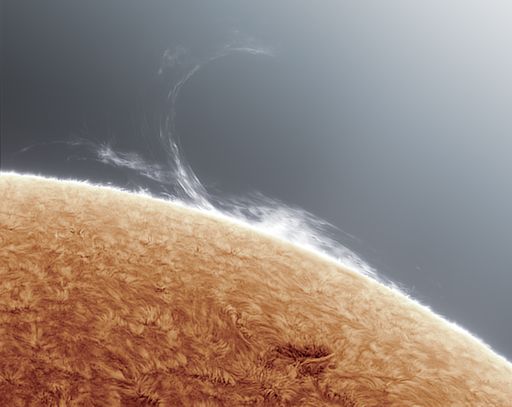It's waiting for you: The most successful Aurora Photo Tour on Earth! 100% success rate 4 years in a row and winner of the TripAdvisor Certificate of Excellence Award. Join LapplandMedia's aurora tours in Abisko, Swedish Lapland! | | | THE SUN IS STILL BLANK: For the fourth day in a row, the face of the sun is blank--no sunspots. As a result, solar activity is low. NOAA forecasters say the chance of a strong solar flare today is no more than 1%. Solar flare alerts: text or voice WHAT'S AROUND THE BEND? The Earth-facing side of the sun is quiet, but the farside is not. We know because yesterday something exploded there, hurling a cloud of plasma over the sun's eastern limb. NASA's Solar Dynamics Observatory recorded a movie of the high-flying debris: 
Within a few days, the underlying blast site should reveal itself as the sun's rotation brings the active region over the horizon. We shall see if it is a large sunspot or something less threatening. Until then, the visible disk of the sun remains blank and the odds of an Earth-directed explosion are low. NOAA forecasters say there is no more than a 1% chance of strong solar flares on June 26th. Solar flare alerts: text or voice Realtime Space Weather Photo Gallery WHEN IS A RAINBOW NOT A RAINBOW? At this time of year, a colorful arc often appears in the noontime sky. It looks like a rainbow, but it's not. "I saw one on June 23rd while I was walking through forest near Flagstaff, Arizona," reports David Blanchard, who took this picture through the treetops: 
Blanchard witnessed a circumhorizon arc--a rainbow-colored band of light caused by the sun shining through plate-shaped ice crystals floating in cirrus clouds. Actual rainbows, on the other hand, are caused by sunlight reflected from raindrops. Summer is the season for circumhorizontal arcs because they appear only when the sun is high in the sky--more than 58o above the horizon. The arc's enormous s ize and pure spectral colors make it one of the most beautiful of all ice halos. At medium latitudes, like much of the USA, the arc is not rare.Typically, it can be seen several times each summer. In contrast, further north in much of Europe the circumhorizon arc is a rarity and impossible to see north of Copenhagen. See the charts in Les Cowley's web page 'How rare?' for the visibility at your location. Realtime Space Weather Photo Gallery SCORPION WITH A MAGNETIC TAIL: As the face of the sun grows quiet, attention is turning to the edge of the sun. "The spotless sun put out a large, fast moving prominence today... a loop that rose and disappeared quickly," reports astrophotographer Alan Friedman of Buffalo, New York. "Frozen in time it looks a bit like a scorpion, no?" 
Prominences are filaments of magnetism filled with glowing-hot plasma. They attract attention when they grow large and hang out over the edge of the solar disk. The magnetic tail of this scorpion is more than 150,000 km long! Even when sunspots vanish, magnetic filaments are known to criss-cross the solar disk. Sometimes they collapse and hit the stellar surface, igniting explosions called Hyder Flares. Readers should expect to see more of these structures as sunspots fade away. Solar Minimum is not boring ... only different. Stay tuned for "quiet." Realtime Space Weather Photo Gallery
Realtime Noctilucent Cloud Photo Gallery
Realtime Sprite Photo Gallery
Realtime Aurora Photo Gallery
Every night, a network of NASA all-sky cameras scans the skies above the United States for meteoritic fireballs. Automated software maintained by NASA's Meteoroid Environment Office calculates their orbits, velocity, penetration depth in Earth's atmosphere and many other characteristics. Daily results are presented here on Spaceweather.com. On Jun. 26, 2016, the network reported 45 fireballs.
(43 sporadics, 1 Microscorpiid, 1 Northern June Aquilid)  In this diagram of the inner solar system, all of the fireball orbits intersect at a single point--Earth. The orbits are color-coded by velocity, from slow (red) to fast (blue). [Larger image] [movies] Potentially Hazardous Asteroids ( PHAs) are space rocks larger than approximately 100m that can come closer to Earth than 0.05 AU. None of the known PHAs is on a collision course with our planet, although astronomers are finding new ones all the time. On June 26, 2016 there were potentially hazardous asteroids. Notes: LD means "Lunar Distance." 1 LD = 384,401 km, the distance between Earth and the Moon. 1 LD also equals 0.00256 AU. MAG is the visual magnitude of the asteroid on the date of closest approach. | | Cosmic Rays in the Atmosphere | | Situation Report -- Oct. 30, 2015 | Stratospheric Radiation (+37o N) | | Cosmic ray levels are elevated (+6.1% above the Space Age median). The trend is flat. Cosmic ray levels have increased +0% in the past month. | | Sept. 06: 4.14 uSv/hr (414 uRad/hr) | | Sept. 12: 4.09 uSv/hr (409 uRad/hr) | | Sept. 23: 4.12 uSv/hr (412 uRad/hr) | | Sept. 25: 4.16 uSv/hr (416 uRad/hr) | | Sept. 27: 4.13 uSv/hr (413 uRad/hr) | | Oct. 11: 4.02 uSv/hr (402 uRad/hr) | | Oct. 22: 4.11 uSv/hr (411 uRad/hr) | These measurements are based on regular space weather balloon flights: learn more. Approximately once a week, Spaceweather.com and the students of Earth to Sky Calculus fly "space weather balloons" to the stratosphere over California. These balloons are equipped with radiation sensors that detect cosmic rays, a surprisingly "down to Earth" form of space weather. Cosmic rays can seed clouds, trigger lightning, and penetrate commercial airplanes. Our measurements show that someone flying back and forth across the continental USA, just once, can absorb as much ionizing radiation as 2 to 5 dental X-rays. For example, here is the data from a flight on Oct. 22, 2015: 
Radiation levels peak at the entrance to the stratosphere in a broad region called the "Pfotzer Maximum." This peak is named after physicist George Pfotzer who discovered it using balloons and Geiger tubes in the 1930s. Radiation levels there are more than 80x sea level. Note that the bottom of the Pfotzer Maximim is near 55,000 ft. This means that some high-flying aircraft are not far from the zone of maximum radiation. Indeed, according to the Oct 22th measurements, a plane flying at 45,000 feet is exposed to 2.79 uSv/hr. At that rate, a passenger would absorb about one dental X-ray's worth of radiation in about 5 hours. The radiation sensors onboard our helium balloons detect X-rays and gamma-rays in the energy range 10 keV to 20 MeV. These energies span the range of medical X-ray machines and airport security scanners. | | The official U.S. government space weather bureau | | | The first place to look for information about sundogs, pillars, rainbows and related phenomena. | | | Researchers call it a "Hubble for the sun." SDO is the most advanced solar observatory ever. | | | 3D views of the sun from NASA's Solar and Terrestrial Relations Observatory | | | Realtime and archival images of the Sun from SOHO. | | | from the NOAA Space Environment Center | | | the underlying science of space weather |  | Tobi -- Proud Supporter of Space Education! |  | Claim your tax refund with this UK tax rebate company and get back your overpaid tax. |  | Enjoy this fabulous range of leather sofas from a leader in the UK sofa manufacturer industry.. | | 
